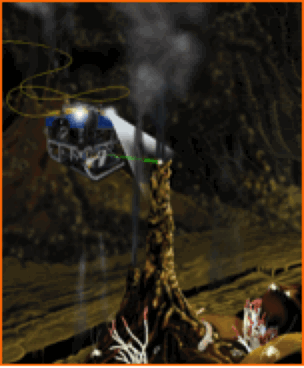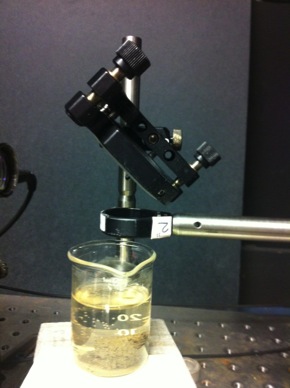
The LIBS technique requires no consumables or sample preparation and thus has applicability to geological, biological, and chemical samples. Due to the diverse nature of the samples, LIBS shows promise to a range of oceanographic applications. For example, our previous laboratory work has demonstrated its capabilities for dissolved analytes in high pressure liquids, making it a viable technique for deep sea applications such as hydrothermal vent fluids.

We are currently investigating the use of LIBS for in situ sediment analysis. Highly contaminated sediments exist in harbors, coastal environments, and estuarine environments in locations around the globe due to shipping, poor management of waste, and anthropogenic inputs. Contaminated sediment is detrimental to fisheries, shell fishing, benthic communities, and human health thus remediation efforts are often necessary. Of key concern in many locations are high levels of heavy metals due to their detrimental impacts on human health. Measurement of heavy metals in sediments is of interest for identifying areas with elevated levels that should be targeted for remediation and for monitoring levels during and after remediation efforts. Monitoring efforts are time intensive and sampling is spatially limited. These efforts require sediment sampling which typically involves a boat and grab sampler or corer followed by often extensive sample processing and finally laboratory-based measurements. Sensors that can be deployed on remotely operated vehicles (ROVs) and autonomous underwater vehicles (AUVs) for rapid, in situ measurements enabling large spatial measurements would greatly improve sediment monitoring efforts. Large spatial surveys of heavy metal levels in sediments is time intensive due to the current technologies that exist for their analyses. Novel sensors deployable on underwater submersibles that can provide rapid, in situ measurements of heavy metal concentrations will enable large spatial studies to be made directly in the field without the need for sample collection and processing.

- Michel, A. P. M., A review of single-shot laser-induced breakdown spectroscopy, Spectrochimica Acta Part B, 65B, 185-191, (2010) (http://dx.doi.org/10.1016/j.sab.2010.01.006).
- Michel, A. P. M., and A. D. Chave. Single pulse laser-induced breakdown spectroscopy of bulk aqueous solutions at oceanic pressures: interrelationship of gate delay and pulse energy, Applied Optics, 47, 122-130, (2008), (http://dx.doi.org/10.1364/AO.47.00G122)
- Michel, A. P. M., and A. D. Chave. Double pulse laser-induced breakdown spectroscopy of bulk aqueous solutions at oceanic pressures: interrelationship of gate delay, pulse energies, interpulse delay, and pressure, Applied Optics, 47, 131-143, (2008), (http://dx.doi.org/10.1364/AO.47.00G131).
- Michel, A. P. M., and A. D. Chave, Analysis of laser-induced breakdown spectroscopy (LIBS) spectra: The case for extreme value statistics, Spectrochimica Acta Part B, 62, 1370-1378, (2007), (http://dx.doi.org/10.1016/j.sab.2007.10.027).
- Michel, A. P. M., M. Lawrence-Snyder, S. M. Angel, and A. D. Chave, Laser-induced Breakdown Spectroscopy of Bulk Aqueous Solutions at Oceanic Pressures: Evaluation of Key Measurement Parameters, Applied Optics, 46, 2507-2515, (2007), (http://dx.doi.org/10.1364/AO.46.002507).
- Lawrence-Snyder, M., J. Scaffidi, S. Michael Angel, A. P. M. Michel, and A. D. Chave, Sequential-Pulse Laser-Induced Breakdown Spectroscopy of High-Pressure Bulk Aqueous Solutions, Applied Spectroscopy, 61, 171-176, (2007), (http://www.opticsinfobase.org/as/abstract.cfm?URI=as-61-2-171).